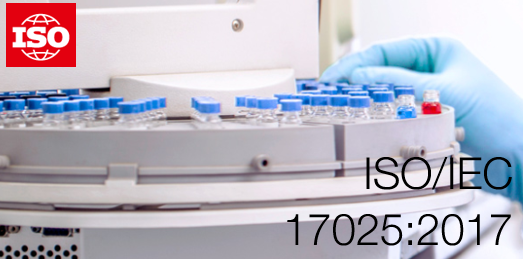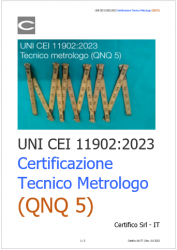Nuova edizione di ISO/IEC 17025
| ID 5131 | | Visite: 7346 | News | Permalink: https://www.certifico.com/id/5131 |
Nuova edizione di ISO/IEC 17025
ISO 01 Dicembre 2017
ISO/IEC 17025:2017, requisiti generali per la competenza dei laboratori di prova e di taratura , è il riferimento internazionale per i laboratori che svolgono attività di taratura e test in tutto il mondo.
La produzione di risultati validi ampiamente considerati è al centro delle attività di laboratorio. ISO/IEC 17025:2017 consente ai laboratori di implementare un sistema di qualità del suono e dimostrare di essere tecnicamente competenti e in grado di produrre risultati validi e affidabili.
ISO/IEC 17025 aiuta anche a facilitare la cooperazione tra laboratori e altri organismi generando una più ampia accettazione dei risultati tra i paesi. Rapporti di prova e certificati possono essere accettati da un paese all'altro senza la necessità di ulteriori test, che, a loro volta, migliorano il commercio internazionale.
Al fine di riflettere gli ultimi cambiamenti delle condizioni di mercato e della tecnologia, la nuova edizione dello standard comprende le attività e le nuove modalità di lavoro dei laboratori oggi. Copre i cambiamenti tecnici, il vocabolario e gli sviluppi nelle tecniche informatiche e prende in considerazione l'ultima versione della ISO 9001 sulla gestione della qualità.
I tre Convenors del gruppo di lavoro CASCO 44 (CASCO/WG 44) che hanno rivisto lo standard ci dicono perché la nuova versione di ISO/IEC 17025 è così importante per i laboratori:
I laboratori già accreditati ISO/IEC 17025:2005 dovranno trasferire i loro processi alla nuova versione entro un periodo di tre anni dalla data di pubblicazione del nuovo standard.
ISO/IEC 17025:2017 è stato sviluppato congiuntamente dall'ISO e dalla Commissione elettrotecnica internazionale (IEC) sotto la responsabilità del Comitato ISO sulla valutazione della conformità (CASCO).
- Lo scopo è stato rivisto per coprire test, calibrazione e campionamento associati alla successiva calibrazione e test.
- L'approccio al processo corrisponde ora a quello dei nuovi standard come ISO 9001 (gestione della qualità), ISO 15189 (qualità dei laboratori medici) e ISO / IEC 17021-1 (requisiti per gli organismi di audit e certificazione).
- Lo standard ha ora una maggiore attenzione alle tecnologie dell'informazione e incorpora l'uso di sistemi informatici, registrazioni elettroniche e la produzione di risultati e relazioni elettronici.
- Un nuovo capitolo introduce il concetto di pensiero basato sul rischio.
__________
Preview ISO/IEC 17025:2017
Foreword
ISO (the International Organization for Standardization) is a worldwide federation of national standards bodies (ISO member bodies). The work of preparing International Standards is normally carried out through ISO technical committees. Each member body interested in a subject for which a technical committee has been established has the right to be represented on that committee. International organizations, governmental and non-governmental, in liaison with ISO, also take part in the work. In the field of conformity assessment, ISO and the International Electrotechnical Commission (IEC) develop joint ISO/IEC documents under the management of the ISO Committee on Conformity assessment (ISO/CASCO).
The procedures used to develop this document and those intended for its further maintenance are described in the ISO/IEC Directives, Part 1. In particular the different approval criteria needed for the different types of ISO documents should be noted. This document was drafted in accordance with the editorial rules of the ISO/IEC Directives, Part 2 (see www.iso.org/directives).
Attention is drawn to the possibility that some of the elements of this document may be the subject of patent rights. ISO shall not be held responsible for identifying any or all such patent rights. Details of any patent rights identified during the development of the document will be in the Introduction and/or on the ISO list of patent declarations received (see www.iso.org/patents).
Any trade name used in this document is information given for the convenience of users and does not constitute an endorsement.
For an explanation on the voluntary nature of standards, the meaning of ISO specific terms and expressions related to conformity assessment, as well as information about ISO's adherence to the World Trade Organization (WTO) principles in the Technical Barriers to Trade (TBT) see the following URL: www.iso.org/iso/foreword.html.
This document was prepared by the ISO Committee on Conformity Assessment (CASCO) and circulated for voting to the national bodies of both ISO and IEC, and was approved by both organizations.
This third edition cancels and replaces the second edition (ISO/IEC 17025:2005), which has been technically revised.
The main changes compared to the previous edition are as follows:
— the risk-based thinking applied in this edition has enabled some reduction in prescriptive requirements and their replacement by performance-based requirements;
— there is greater flexibility than in the previous edition in the requirements for processes, procedures, documented information and organizational responsibilities;
— a definition of “laboratory” has been added (see 3.6).
Introduction
This document has been developed with the objective of promoting confidence in the operation of laboratories. This document contains requirements for laboratories to enable them to demonstrate they operate competently, and are able to generate valid results. Laboratories that conform to this document will also operate generally in accordance with the principles of ISO 9001.
This document requires the laboratory to plan and implement actions to address risks and opportunities. Addressing both risks and opportunities establishes a basis for increasing the effectiveness of the management system, achieving improved results and preventing negative effects. The laboratory is responsible for deciding which risks and opportunities need to be addressed.
The use of this document will facilitate cooperation between laboratories and other bodies, and assist in the exchange of information and experience, and in the harmonization of standards and procedures. The acceptance of results between countries is facilitated if laboratories conform to this document.
In this document, the following verbal forms are used:
— “shall” indicates a requirement;
— “should” indicates a recommendation;
— “may” indicates a permission;
— “can” indicates a possibility or a capability.
Further details can be found in the ISO/IEC Directives, Part 2.
For the purposes of research, users are encouraged to share their views on this document and their priorities for changes to future editions. Click on the link below to take part in the online survey:
17025_ed3_usersurvey
1 Scope
This document specifies the general requirements for the competence, impartiality and consistent operation of laboratories.
This document is applicable to all organizations performing laboratory activities, regardless of the number of personnel.
Laboratory customers, regulatory authorities, organizations and schemes using peer-assessment, accreditation bodies, and others use this document in confirming or recognizing the competence of laboratories.
2 Normative references
The following documents are referred to in the text in such a way that some or all of their content constitutes requirements of this document. For dated references, only the edition cited applies. For undated references, the latest edition of the referenced document (including any amendments) applies.
ISO/IEC Guide 99, International vocabulary of metrology — Basic and general concepts and associated terms (VIM)1
ISO/IEC 17000, Conformity assessment — Vocabulary and general principles
3 Terms and definitions
For the purposes of this document, the terms and definitions given in ISO/IEC Guide 99 and ISO/IEC 17000 and the following apply.
ISO and IEC maintain terminological databases for use in standardization at the following addresses:
— ISO Online browsing platform: available at https://www.iso.org/obp
— IEC Electropedia: available at http://www.electropedia.org/
3.1 impartiality
presence of objectivity
Note 1 to entry: Objectivity means that conflicts of interest do not exist, or are resolved so as not to adversely influence subsequent activities of the laboratory (3.6).
Note 2 to entry: Other terms that are useful in conveying the element of impartiality include “freedom from conflict of interests”, “freedom from bias”, “lack of prejudice”, “neutrality”, “fairness”, “open-mindedness”, “even-handedness”, “detachment”, “balance”.
[SOURCE: ISO/IEC 17021‑1:2015, 3.2, modified — The words “the certification body” have been replaced by “the laboratory” in Note 1 to entry, and the word “independence” has been deleted from the list in Note 2 to entry.]
3.2 complaint
expression of dissatisfaction by any person or organization to a laboratory (3.6), relating to the activities or results of that laboratory, where a response is expected
[SOURCE: ISO/IEC 17000:2004, 6.5, modified — The words “other than appeal” have been deleted, and the words “a conformity assessment body or accreditation body, relating to the activities of that body” have been replaced by “a laboratory, relating to the activities or results of that laboratory”.]
3.3 interlaboratory comparison
organization, performance and evaluation of measurements or tests on the same or similar items by two or more laboratories in accordance with predetermined conditions
[SOURCE: ISO/IEC 17043:2010, 3.4]
3.4 intralaboratory comparison
organization, performance and evaluation of measurements or tests on the same or similar items within the same laboratory (3.6) in accordance with predetermined conditions
3.5 proficiency testing
evaluation of participant performance against pre-established criteria by means of interlaboratory comparisons (3.3)
[SOURCE: ISO/IEC 17043:2010, 3.7, modified — Notes to entry have been deleted.]
3.6 laboratory
body that performs one or more of the following activities:
- testing;
- calibration;
- sampling, associated with subsequent testing or calibration
Note 1 to entry: In the context of this document, “laboratory activities” refer to the three above-mentioned activities.
3.7 decision rule
rule that describes how measurement uncertainty is accounted for when stating conformity with a specified requirement
3.8 verification
provision of objective evidence that a given item fulfils specified requirements
EXAMPLE 1:Confirmation that a given reference material as claimed is homogeneous for the quantity value and measurement procedure concerned, down to a measurement portion having a mass of 10 mg.
EXAMPLE 2:Confirmation that performance properties or legal requirements of a measuring system are achieved.
EXAMPLE 3:Confirmation that a target measurement uncertainty can be met.
Note 1 to entry: When applicable, measurement uncertainty should be taken into consideration.
Note 2 to entry: The item may be, for example, a process, measurement procedure, material, compound, or measuring system.
Note 3 to entry: The specified requirements may be, for example, that a manufacturer's specifications are met.
Note 4 to entry: Verification in legal metrology, as defined in VIML, and in conformity assessment in general, pertains to the examination and marking and/or issuing of a verification certificate for a measuring system.
Note 5 to entry: Verification should not be confused with calibration. Not every verification is a validation (3.9).
Note 6 to entry: In chemistry, verification of the identity of the entity involved, or of activity, requires a description of the structure or properties of that entity or activity.
[SOURCE: ISO/IEC Guide 99:2007, 2.44]
3.9 validation
verification (3.8), where the specified requirements are adequate for an intended use
EXAMPLE:A measurement procedure, ordinarily used for the measurement of mass concentration of nitrogen in water, may be validated also for measurement of mass concentration of nitrogen in human serum.
[SOURCE: ISO/IEC Guide 99:2007, 2.45]
Fonte: ISO
Correlati:
Tags: Normazione Norme ISO





















